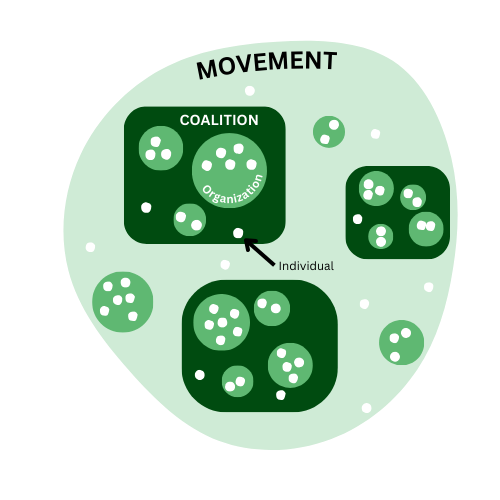Organization – a group of people working together towards a common purpose.
- Working groups – Sub-groups within the organization that work on a specific project. This tends to simplify task delegation and increases efficiency for the organization as a whole.
- Chapters or Nodes – larger-scale organizations (state-wide, nation-wide, international) are sometimes split into smaller, more local groups. Chapters often aim to engage their local communities in their organization’s work, and/or provide a local perspective on certain issues for the larger-scale organization. An example of this is 350 Mass, which has nodes in Watertown, the North Shore region, Lowell, and more.
Coalition – a group of organizations working together towards a common goal. Because coalitions tend to encompass more people and have access to more resources than a singular organization, coalitions can be more effective in their initiatives, such as getting legislation passed.
Movement – the broader push for change, often social change, amongst the people. The world-wide environmental movement, for example, encompasses all the individuals, organizations, coalitions, governments, etc. that are aiming to protect the natural world from human harm.
(Diagram inspired by Alice Fan)

Environmental change vs. Climate change: These terms have been used interchangeably, but there are differences!
- Environmental change refers to a broad spectrum of changes in the natural world, which can be on local, regional, or global levels. Climate change is included within the broader category of environmental change. Some other examples include deforestation, air pollution, water pollution, habitat destruction, and rising sea levels.
- Climate change refers to changes in the long-term weather patterns for certain regions of the world, typically due to atmospheric changes. Climate change is actually a natural process that Earth has undergone throughout its existence, but human influence is expediting climate change in an unnatural and dangerous way, causing an array of environmental issues.
- Global warming is the most prominent example of climate change, but some specific examples include the increase in ice melt in Greenland, or the increase in hurricane frequency in the Caribbean.
Environmental Justice (EJ): The fair treatment and meaningful involvement of all people, regardless of their race, color, national origin, or income, in the development, implementation and enforcement of environmental policies (US EPA). This concept is especially important because low-income and marginalized communities are disproportionately impacted by environmental issues, and often are overlooked in environmental initiatives.
- Environmental Justice Organization: Environmental Justice organizations are located in an EJ community, serving primarily individuals with environmental justice identities.
- Individuals with Environmental Justice Identities: People who live in environmental justice populations, or who identify with groups who have been and will be disproportionately impacted by the climate crisis, including but not limited to those at intersecting systems of oppression across race, class, geography, language isolation, citizenship status, ability, sexual and gender identity, and exposure to Environmental Burdens.
Legislative Advocacy: Organization promotes policy with a climate or environmental focus in a lobbying, testifying, or writing capacity
Conservation and Cultivation: These organizations primarily focus on protecting and/or expanding nature areas. Conservation organizations are particularly interested in protecting pre-existing nature areas. Cultivation organizations aim to cultivate nature, such as gardens, particularly in areas that lack access to green spaces.
Local Community Engagement: These organizations focus on environmental issues relevant to a particular geographical location or community, and aim to engage their local community in environmental initiatives, such as switching to renewable energy sources.
Public Awareness/Education: These organizations primarily aim to raise awareness about and educate people on environmental issues in the public. This can happen locally and/or statewide.
Environmental Justice (EJ) Organization: Environmental Justice organizations are typically located in an EJ community, serving primarily individuals with environmental justice identities.
NOTE: Just because an organization was placed in a certain category on Envirolaunch doesn’t mean that it ONLY does activities in that category! The category placement only indicates what we believe the organization primarily focuses on, based on our research and communications with each organization.
Youth-Led: Organization leadership consists of and is led entirely by youth, sometimes with adults collaborating in a supporter role
Youth-Centered: Organization has volunteer opportunities specifically for youth that focuses on promoting the education and involvement of youth, with adults collaborating in an administrative or supporter role
Youth-Friendly: Organization has volunteer opportunities that youth are invited to participate in.